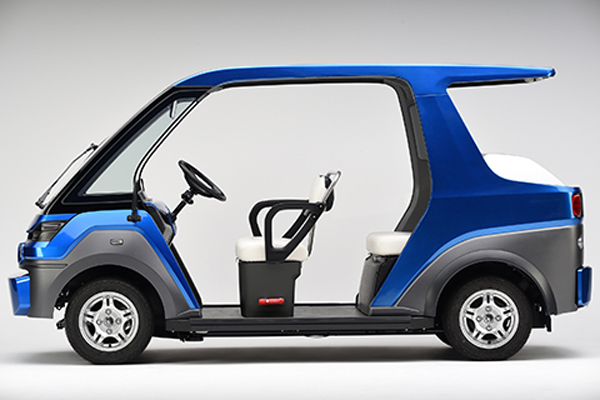
Recent vehicle news from Asia spurred some thoughts on the opportunity urban mobility presents to small, task-oriented vehicle (STOV) manufacturers.
Urban Mobility Changing
Battery Swapping Autorickshaws
The first article reports on the use of battery swapping to power electric autorickshaws in India. Battery swapping removes the very expensive battery component from the upfront purchase price and reduces long term operating costs. In addition, the electric part moves toward a more climate friendly and less polluting transportation system.
The current thinking by some is that smaller two and three-wheeled vehicles provide the best economic case for battery swapping. In contrast, larger vehicles require larger batteries. This means more expensive and complicated swapping stations, and higher up front investment costs for the battery supplier. While this an India based example, the advent of e-scooters, e-bikes and startups offering three wheelers indicate market potential in the US.
Fuel Cell Powered Small Vehicle
This week Yamaha Motor announced the public testing of a prototype fuel cell vehicle for a vehicle sharing service. The vehicle looks like less than a typical automobile but more than a golf car. The technology advances new concepts in urban mobility as well as initiatives in Japan to promote hydrogen based fueling. Though the fuel cell provides greater range and less refueling needs, the more important part of this test for STOV OEMs is the vehicle form. The vehicle size and level of complexity should be a good fit for their capabilities.
Is Urban Mobility Too Small for Traditional Auto OEMs?
These transportation technologies represent a new opportunity for STOV manufacturers to leverage their existing manufacturing and technology expertise into new vehicle markets. The traditional automobile manufacturers are less likely to view these markets as an opportunity. Although, in the long term they could represent a threat to their dominance or at least reduce their addressable market. They are already pouring billions of dollars to enter the highway capable EV market. However, they must balance investment between highly profitable and traditionally popular ICE vehicles and lower margin and riskier EVs. Smaller, alternative energy vehicles are even farther down the list. In addition, their work force arguably did not join their companies to produce small, urban vehicles.
Urban Mobility Attracts Diverse Providers
Entrants in the urban mobility space include startups like Arcimoto and traditional small vehicle manufacturers serving Asian and to a lesser degree European markets. Startups have the advantage of creating purpose-built vehicles specifically for new mobility markets. However, they lack the manufacturing expertise, financial resources and distribution networks. Traditional foreign small vehicle manufacturers know their home markets, and have the distribution, financing and manufacturing assets. However, they do not have a strong presence in the US market.
Other potential entrants include the likes of bike sharing companies as well as Lyft and Uber that have moved into ride sharing with e-scooters and e-bikes. However, these company’s expertise is not in manufacturing. They provide the platform for people to access mobility. One can argue that the platform itself does not provide as a wide moat as the manufacturing and technology assets. The strengths and weaknesses of these potential providers and the dynamics of the urban mobility market suggest an opening for existing US STOV manufacturers.
Best Positioned US STOV Market Leaders
Among the current leading UTV, golf car and LSV manufacturers companies Polaris, Textron and Yamaha appear to be best positioned to pursue this new opportunity. Polaris owns Aixam, the leading European quadricycle brand as well as the GEM, Goupil and Taylor-Dunn electric vehicle brands. These brands provide them with electric vehicle technology as well as a range of distribution networks. On the other hand, the DNA and profit driver of Polaris is off-road motorsports. They may see relatively greater returns on investment in their traditional markets.
After the acquisition of Arctic Cat, Textron is similar to Polaris and now has an expansive small vehicle portfolio. Their DNA is more golf car and PTV, and therefore likely better suited towards urban mobility. However, the integration of Arctic Cat has been bumpy and they were slow to recognize the original UTV opportunity. As a piece of a larger conglomerate, their Textron Specialized Vehicle division may not be entrepreneurial enough or have the freedom to pursue this opportunity.
Yamaha has both off-road and golf car type offerings as well as e-bikes, but are not well coordinated. These businesses are in separate business units. In addition, their golf car portfolio has been emphasizing gas powered technology rather than electric technology. Yamaha’s existing mobility concept testing along with having one foot in the Asian market and another in the US should be an advantage. However, their slow re-entry into the UTV market after problems with the Rhino side-by-side speaks to a more cautious corporate approach.
The STOV OEMs appear to have many of the necessary requirements to pursue the urban mobility opportunity. The question remains whether they believe in the opportunity and if they are willing to take the risk.
Marc Cesare, Smallvehicleresource.com
